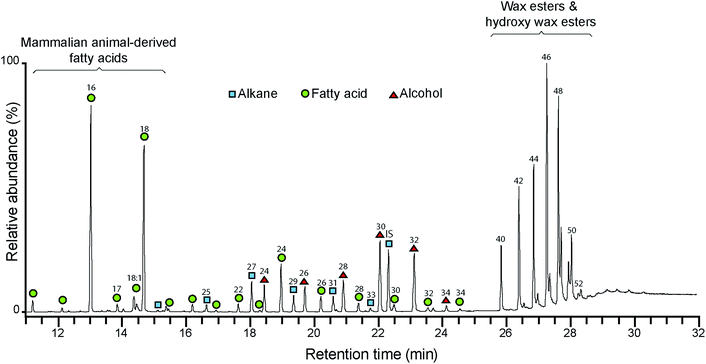Wax and wax-like materials – the what, where, and how in heritage collections
Analytical Methods Committee AMCTB No. 103
First published on 27th April 2021
Abstract
Waxes, both natural and synthetic, are present throughout heritage collections – from archaeological and ethnographic, archival and historical, to traditional and contemporary art. Very often wax-containing objects show degradation issues: analytical chemistry, by allowing us to understand the original composition and the degradation mechanisms of these materials, provides the key to designing appropriate conservation strategies and materials for wax-containing objects in our heritage collections.
What is it?
Beeswax may be the earliest material of this class to be used by humans, but it is not the only one found in heritage collections. Other waxes include:• Animal-derived – insect, shellac, spermaceti, and wool waxes, hydrolysed animal fats (palmitic and stearic acids) in the form of stearin;
• Plant-derived waxes – Japan, carnauba and candelilla wax; and,
• Mineral and fossil- or coal-derived waxes such as ozokerite, montan wax and paraffin.
Despite the diversity in their origin, all waxes tend to be malleable solids at room temperature with relatively low melting points (40–85 °C), are hydrophobic, and are characterised by an organic lipophilic molecular composition.
Where is it?
Waxes have been used since ancient times as sealants, polishes, lubricants and adhesives due to their hydrophobic (water-repellent) and thermoplastic (pliable/mouldable when heated) qualities. They have also been used:• to make candles and fuel lamps;
• to validate and secure documents via wax seals throughout the medieval to early modern period;
• as sculptural materials;
• as temporary rendering in lost-wax metal casting processes;
• to create detailed designs on textiles through the batik technique†;
• as pigment binders in encaustic paintings‡;
• to line the canvas of paintings during historic conservation campaigns;
• to create models of the anatomy of humans and other animals, plants, and fungi; and,
• as components in a variety of modern and contemporary artworks.
Why do we care?
The analysis of waxes in heritage collections gives us insight into early human technologies, material innovation, use, and trade – but is also relevant for conservation and long-term preservation purposes. Because of their malleable nature, objects made from, or containing waxes are prone to damage, and conservation-grade adhesives and consolidants§ appropriate for their repair are still under-developed. Additionally, many waxes are a mixture of compounds with different molecular weights, polarities and volatilities, which may over time separate, exude or evaporate. These processes may be accelerated by elevated temperatures that approach the melting point of individual components in beeswax or mixed waxy materials. Current trends in climate change resulting in large temperature swings during some months of the year could create high-risk conditions for wax-containing objects, making them particularly vulnerable during transport and display.Aged wax, which has undergone some of the degradation processes described above, may have an entirely different, often more rigid and brittle behaviour. Complicating the matter further, waxes were sometimes used neat, but are more often found imbibed into another material (e.g. textile or ceramic) or mixed with one or several other components to alter their rheology and opacity. For example, resins are added to create a harder texture, starch or flour may be used as extenders and opacifiers, and pigments and colorants are commonly incorporated. The presence of these additives affects the stability and longevity of the final material. Wax seals, for example, often display a fragile, layered, pastry dough-like structure as a result of the kneading method used to incorporate pigments and resins into the beeswax prior to sealing (Fig. 1).
Composition and analysis of beeswax
Beeswax is a complex mixture of long-chain wax esters, hydrocarbons, fatty acids, and other organic components, the relative proportion of which can vary depending on the wax’s origin (e.g. on the species and feeding habits of the bees). The long organic molecules in wax can crystallise in two forms, an orthorhombic structure composed of esters and non-functionalised polymethylenes, and a monoclinic one, containing alcohols and fatty acids. This crystalline, organised portion of the wax comprises approximately two thirds of the total mass; the rest of the wax structure is amorphous.Because of its relative prevalence, beeswax is the most extensively studied wax in the context of heritage science. For this reason, the analysis methods outlined below (some of the techniques described are destructive whereas others are non-destructive) will focus on this material, but may be applicable to other types of wax. The most common scientific techniques used for the characterization of beeswax are Fourier-transform infrared spectroscopy (FTIR) and gas chromatography coupled with mass spectroscopy (GC-MS), although many other complementary techniques can also be used. Both methods are primarily used to determine if an object is composed of, or contains, wax, as well as to differentiate the types of wax present. In some instances, these methods have been employed to understand the ageing behaviour of waxes.
FTIR spectra of beeswax are dominated by the hydrocarbons, fatty acids, and esters (Fig. 2). The hydrocarbon signals are seen as very strong –CH2 asymmetric and symmetric stretches at ca. 2920 and 2850 cm−1, respectively, –CH2 scissoring at ca. 1470 cm−1, and backbone –CH2 rocking as a doublet at ca. 720 cm−1; a carbonyl stretch ca. 1735 cm−1 (esters), commonly with a shoulder at ca. 1710 cm−1 (free fatty acids), as well as a C–O ester stretch present at ca. 1170 cm−1.1 In aged wax, the carbonyl shoulder (1710 cm−1) tends to become more pronounced, and sometimes an –OH stretching band (3600–3200 cm−1) may appear, both a result of ester degradation.
GC-MS is by far the most common analytical technique for wax characterisation in heritage objects.2 The unknown composition and mixed nature of heritage wax samples may make it difficult to select the most appropriate experimental conditions and obtain a complete profile of the material but several studies have addressed this challenge. Distinguishing between different types of waxes in a GC-MS total or reconstructed ion chromatogram relies on the evaluation of the retention peaks in the chromatogram, corresponding to variations in the components of the wax (Fig. 3).
X-ray diffractometry (XRD) has been used to assess the change in crystallinity in various mixtures with changes in environmental conditions, or with ageing. It is this method that has provided clues to the changing physical behaviour and embrittlement of beeswax and mixed materials. This technique has been particularly helpful in the study of anatomical wax models, which tend to display a white, powdery efflorescence, or bloom, as they age.
X-ray fluorescence spectroscopy (XRF) can be used to assess inorganic additives (e.g. pigments in seals and encaustic paintings) or degradation products in wax objects. For example, in their analysis of the modern modelling materials used by sculptor Aguste Rodin, Langlois et al. detected the presence of fillers (calcium carbonate), and used μXRF (in combination with μFTIR and μXANES) to glean a better understanding of protrusions that were disrupting the surface of the sculptures.3
X-ray micro computed tomography (μ-CT)4 has been used to image the micro-layered structure of fragile and severely degraded ‘white seals’, which are particularly prone to flaking (Fig. 1).
Stable isotope analysis can help in differentiating between waxes found in archaeological samples (e.g. plant-derived vs. beeswax); along with lipid residue analyses using GC-MS, spatio-temporal information about waxes found in archaeological samples can be mapped to provide insight into our ancestors’ exploitation of honeybees and beeswax.
Nuclear magnetic resonance spectroscopy (NMR), both 1H and 13C, has been used in the analysis and characterisation of wax seals. Along with other methods, such as calorimetry, FTIR and GC-MS, researchers have shown that the wax ‘bloom’ occurring on the surface of some wax objects is composed predominantly of unsaturated hydrocarbons, which constitute the amorphous portion of the beeswax structure and can migrate to the surface over time, causing embrittlement of these objects.
Metabolomics and metagenomic methods (DNA extraction, amplification and sequencing, bioinformatics analyses of sequenced data) have recently been employed to characterise microbial activity on wax seals, and to demonstrate that these objects are susceptible to biodeterioration by a variety of bacteria and fungi. This information is relevant not only in determining preservation strategies, but in protecting conservators and members of the public that may come in contact with these bioagents on objects.
Despite the wide-ranging analytical methodology applied to wax and wax-like materials in heritage science, conservation of items containing these materials is still complex and, in some cases, not possible. Historic conservation methods include the use of fresh beeswax, propolis¶, and various resins for the re-adhesion of broken parts; recently, synthetic polymer adhesives have also been introduced for this purpose. Unfortunately, many of these adhesives pose new problems (e.g. they are stronger than the historic material and cause new breaks, or they are non-reversible or age poorly and are unstable). Even more complex is the consolidation of embrittled wax objects, like white seals. Research into the most appropriate materials and methods for the conservation of wax objects is ongoing, and is often addressed on a case-by-case basis (e.g. the recent conservation of Anne Marie Carl-Nielsen’s wax models5). Analytical chemistry provides the tools to characterise wax-containing objects in heritage collections, to understand their degradation mechanisms and to design acceptable conservation methods.
Dr Lora Angelova, Collection Care Department, The National Archives, UK
This Technical Brief was prepared for the Analytical Methods Committee (AMC), with contributions from members of the AMC Heritage Science Expert Working Group, and approved by the AMC on 15 February 2021.
Further reading
- L. Shearer, An evaluation of Fourier transform infrared spectroscopy for the characterization of organic compounds in art and archaeology, PhD thesis, University College London, 1989.
- M. Regert, Direct Mass Spectrometry to Characterise Wax and Lipid Materials, in Organic Mass Spectrometry in Art and Archaeology, ed. M. P. Colombini and F. Modugno, John Wiley & Sons, Sussex, UK, 2009, pp. 97–129 Search PubMed.
- J. Langlois, G. Mary, H. Bluzat, A. Cascio, N. Balcar, Y. Vandenberghe and M. Cotte, Analysis and conservation of modern modeling materials found in Auguste Rodin’s sculptures, Studies in Conservation, 2017, 62(5), 247–265, DOI:10.1080/00393630.2015.1131029.
- Analytical Methods Committee AMCTB No. 98, X-ray micro computed tomography in cultural heritage, Anal. Methods, 2020, 12, 4496–4500, 10.1039/D0AY90112A.
- D. Gramtorp, K. Botfeldt, J. Glastrup and P. Kim, Investigation and conservation of Anne Marie Carl-Nielsen’s wax models, Studies in Conservation, 2015, 60(2), 97–106, DOI:10.1179/2047058413Y.0000000111.
Footnotes |
| † An Indonesian technique of wax-resist dyeing applied to the whole cloth. |
| ‡ Using heated beeswax to which colored pigments are added. |
| § Substances applied to materials, such as rotten wood, to provide solidity and strength. |
| ¶ A generic name that refers to the resinous substance accumulated by the bees from different types of plant. |
| This journal is © The Royal Society of Chemistry 2021 |





